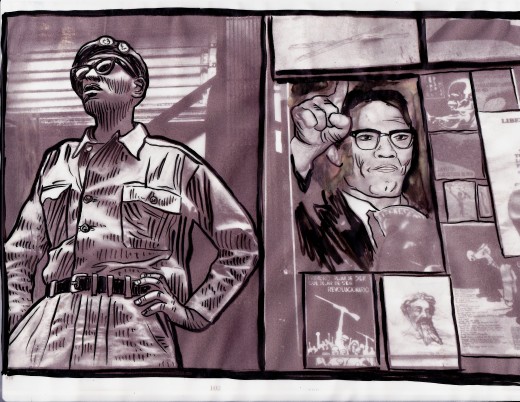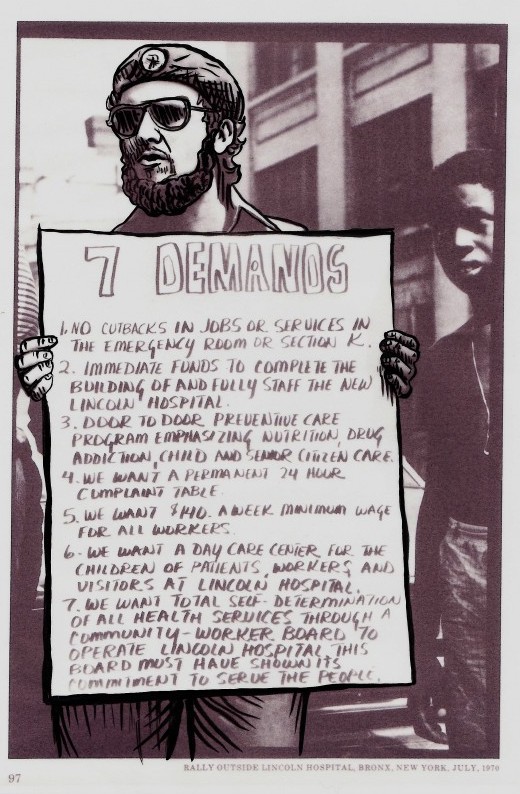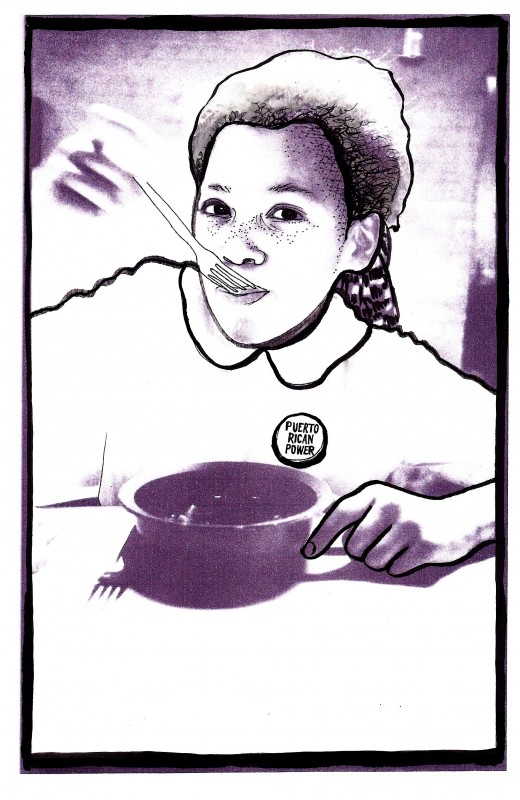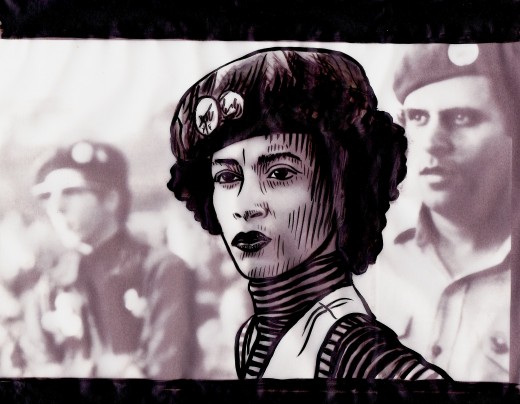The Young Lords: A Brief Introduction with Some Illustrations…
I am surprised that my friend Billy hasn’t disowned me yet. For over a year, I’ve promised to write a few words about the Young Lords for a zine that ze has illustrated. I’ve been distracted, then swamped, then distracted again. So to push myself to work on this, I’m writing a post today. It’s very drafty but I need the kick in the butt…
THE YOUNG LORDS
There had of course been Puerto Rican nationalist organizations throughout the early to mid-20th century. But they mostly focused on the struggle for Puerto Rican independence. Meanwhile Puerto Ricans on the mainland were living in dire conditions. They experienced poverty, dilapidated housing, substandard schooling and terrible health care. Pedro Pietri gave voice to this marginalization and violence in his amazing spoken word poem titled “Puerto Rican Obituary” which appeared in the 1971 book “Palante.” Below is a short clip of Pietri sharing an excerpt from the piece:
In 1959, seven Puerto Rican young people formed (PDF) the Young Lords in Chicago. The group was initially created to protect its members against attacks from white ethnic, black and other latino ‘gangs.’ Jose “Cha Cha” Jimenez became the group’s chairman in the early 60s.
During the mid to late 60s, many black gangs in Chicago were transforming into political organizations very much influenced by the Black Power movement. Gang members joined the Black Panther Party, the Nation of Islam, and other radical organizations. By 1967, the three largest gangs in Chicago, the Vice Lords, Blackstone Rangers, and the Gangster Disciples founded the LSD (Lords, Stones, and Disciples) peace treaty. This newly formed group ran local businesses (bookstores, cafes, clothing shops) and facilitated political education in their communities.
Puerto Rican gangs underwent a similar process of consciousness-raising and transformation. Cha Cha Jimenez and the Chicago Young Lords re-evaluated their mission & took on the name ‘Young Lords Organization.’ In 1967, they opened Uptight #2, a cafe where they discussed the issues of the day. The Lords established substance abuse programs, gave away food, and organized various community events. After spending time in prison in 1968, Jimenez became particularly interested revolutionary movement-building.
Fred Hampton, the deputy Chairman of the Illinois Black Panther Party, approached Cha Cha Jimenez to discuss a revolutionary framework for liberation. Hampton believed that it was important to marry social service delivery with revolutionary politics. As Jimenez said: “Giving gifts wasn’t going to help their people. They had to deal with the system that was messing them over.”

Che Ja-Ja, Bronx Office, May 1970
Image by Billy Dee (inspired by Palante, photo by Michael Abramson)
The Young Lords co-existed and intersected with several other movements of their era including anti-imperialist, anti-war, women’s liberation, and black freedom struggles. Several Puerto Ricans were particularly active in the New York Chapter of the Black Panther Party in the 1960s. There was a lot of cross movement building.
Iris Morales, who would later become a leader of the Young Lords Party in NY, joined an African-American led student group called ONYX while at City College in New York. She was involved with the Student Non-Violent Coordinating Committee (SNCC) and the NAACP. She studied Malcolm X and other black revolutionaries. She ended up founding City College’s first Puerto Rican organization, Puerto Ricans in Student Activities (PRISA). PRISA made alliances with other campus student groups.
In 1969 at a Students for a Democratic Society gathering (SDS), Joe Martinez (then an SDS member) met with leaders of the Chicago Young Lords & received their permission to establish a chapter of the organization in New York. Importantly up to 25 percent of the membership of the Young Lords Organization was black and 30% were women. Other chapters of the Young Lords Organization would be founded in Newark, Philly, and Bridgeport, Connecticut.
However, it is the New York Chapter of the Young Lords Organization that would become iconic. The New York Lords successfully advocated for improved sanitation in East Harlem and organized against police brutality. Inspired by the Black Panther Party’s free breakfast program, the Lords fed hungry people regularly in their community. Their lead poisoning campaigns eventually resulted in the passage of anti-lead legislation and the establishment of the Bureau of lead poisoning in New York.

Rally at Lincoln Hospital, July 1970 Image by Billy Dee (inspired by photo in Palante by Michael Abramson)
On July 17, 1970, 100 Young Lords occupied Lincoln Hospital to draw attention to the terrible healthcare for the poor. The action gained the attention of NY Mayor, John Lindsay, who said that the city would build a new hospital to replace Lincoln. A new hospital did in fact open on East 149th street in 1976.
Given my work and personal commitments, I’ve been very interested in the YLP’s organizing campaigns against prisons. Similar to the BPP’s 10 point plan, the Young Lords’ Platform included a statement about political prisoners. It was therefore no surprise that prisoners at Attica included the YLP on their list of outside negotiators during the 1971 uprising.
As early as 1969, women within the YLO founded their own caucus. The Women’s Caucus succeeded in getting two women, Denise Oliver and Iris Morales, named to the Central Committee. The women of YLO/YLP were also pioneers in the reproductive justice movement advocating for abortion, contraception, the right of women of color to have children & to be able to raise them free from poverty. They also successfully pushed for sexism to be explicitly addressed in the 13 Point Program and Platform of the Young Lords Organization:
Point #5. WE WANT EQUALITY FOR WOMEN, DOWN WITH MACHISMO AND MALE CHAUVINISM.
Under capitalism, women have been oppressed by both society and our men. The doctrine of machismo has been used by men to take out their frustration on wives, sisters, mothers, and children. Men must fight along with sisters in the struggle for economic and social equality and must recognize that sisters make up over half of the revolutionary army; sisters and brothers are equal fighting for our people. FORWARD SISTERS IN STRUGGLE! (Source: Young Lords Party 13-Point Program & Platform [Revised November 1970])
In May 1970, the New York Chapter of the YLO broke with the Chicago Lords and organized all of the east coast chapters under the umbrella of the Young Lords Party (YLP). After 1972, the Young Lords Party would become known as the Puerto Rican Revolutionary Workers Organization and be led by Gloria Fontanez. The Revolutionary Workers Organization would last until 1976.
Lots of forces including political repression and in-fighting led to the eventual demise of the Young Lords. However, their contributions were important and the history of the organization should be better known.
Sources:
The Young Lords: A Reader (2010). Edited by Darrel Enck-Wanzer
Ogbar, Jeffrey(2006). Puerto Rico en mi corazón:The Young Lords, Black Power and Puerto Rican nationalism in the U.S., 1966–1972. Centro Journal.
Young Lords Party (1971). Palante: Voices and Photographs of the Young Lords, 1969-1971. Photographs by Michael Abramson


